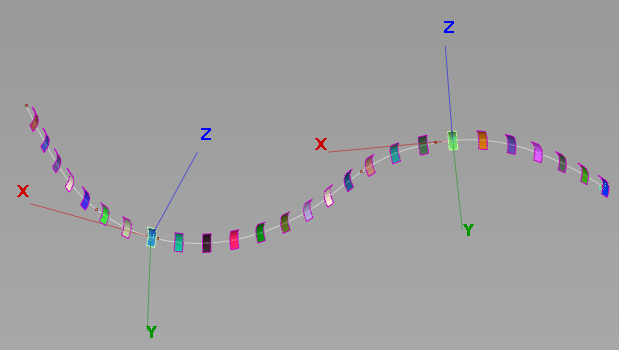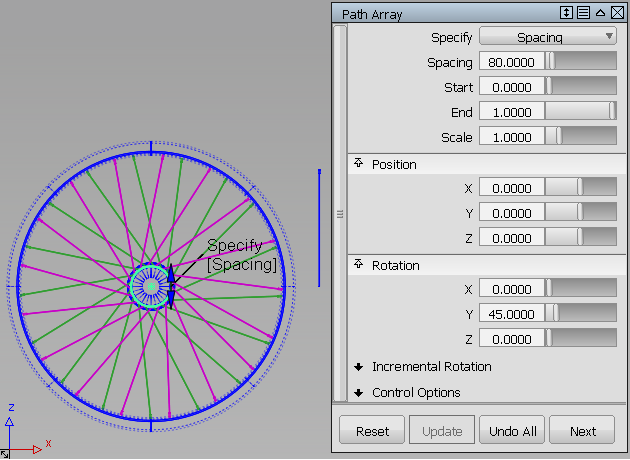Transform > Arrays > Path Array
![]()
Duplicates one or more objects and places the copies at equal distances along one or more curves, creating stitch patterns. You can use this tool to duplicate all geometry types, as well as construction objects, such as points, planes, and vectors.
Access this tool from the Transform tool palette by doing either of the following:
- Clicking this icon:

- Right-clicking Transform and selecting Arrays > Path Array.
Path Array Control
Specify
Choose Spacing or Number from the pull-down menu.
This option also appears as a toggling label on the model.
Spacing / Number
Depending on the value of the Specify option.
Spacing – The distance between the duplicates, in current units.
Number – The number of duplicates.
These values can also be set by using the corresponding manipulator on the model.
Start/End
Specifies where the duplicates start and end along the curve. Start and End values of 0.0 and 1.0 respectively define the original extent.
These values can also be set by using the range manipulators on the path curve.
Scale
This is a relative scale factor applied to the first duplicate to produce the last duplicate. The sizes of intermediate duplicates are linearly interpolated.
Position
Offset in the X, Y, and Z directions along the duplicates local axes (in current units).
Rotation X/Y/Z
Rotation around the local X, Y, and Z axes of the duplicates (in current units).
Incremental Rotation X/Y/Z
Rotation around the local X, Y, and Z axes of the duplicates by a relative angle with respect to the previous duplicate. For example, if the X value is 10.0 (degrees), each duplicate is rotated ten degrees more around X than the previous one. This produces a twisting effect along the path.
Control Options
Auto Update
When checked, duplicates update automatically when values in the control window are changed.
Chain Select
When checked, selecting a curve also selects all other curves that are tangent continuous with it.
Create History
When checked, the duplicates have construction history. Modifying the stitch objects or target curves causes the duplicates to update accordingly.
Range Fit
Check this box to ensure that the duplicates fit the entire length of the curves specified by the Start and End positions. This action sometimes causes the Spacing to change (not reflected in the option window).
Orientation
None – No change in orientation.
Tangent – The first copy of the object takes the original orientation and all subsequent copies are rotated based on the tangent of the input curve at the point where the object is being placed. This allows the arrayed objects to follow the flow of the input curve.
Normal – Aligns the local X axis of each duplicate with the tangent of the target curve at the position of the duplicate. If the target curve is a curve-on-surface, each duplicate is oriented so that its local Z axis matches the normal direction of the surface where the curve-on-surface lies. If the target curve is a free curve, the Z axis of each duplicate is oriented along the direction of the curvature vector of the curve (like plot combs).
 Note:
Note:If the curvature of the curve changes direction, the duplicates orientation does not flip at inflection points.
Example
In the following image, a spoke (two surfaces, shown to the right of the bicycle wheel) is duplicated and placed along a circular path curve (inner rim). The operation is repeated twice to create two sets of spokes: one rotated by 45 degrees around Y (in pink), and the other rotated by 315 degrees around Y (in green).
